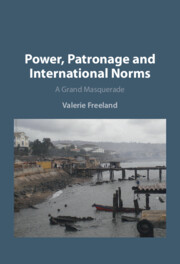Refine search
Actions for selected content:
81 results
3 - An Expatriate Young Lady
-
- Book:
- Love, Class and Empire
- Published online:
- 10 July 2025
- Print publication:
- 04 September 2025, pp 70-104
-
- Chapter
- Export citation
6 - Nart Saga, Indo-Iranian Twins, and Dioscurias
-
- Book:
- Myth, Ritual, and Society in Mycenaean Anatolia
- Published online:
- 18 July 2025
- Print publication:
- 07 August 2025, pp 194-237
-
- Chapter
- Export citation
Tilting at Windmills Opportunistically: The Case of Georgian Far Right
-
- Journal:
- Nationalities Papers , FirstView
- Published online by Cambridge University Press:
- 04 August 2025, pp. 1-24
-
- Article
-
- You have access
- Open access
- HTML
- Export citation
Informal Sanctions and Patriotism From Below: Georgian-Russian Encounters in Tbilisi’s Housing Market in 2022
-
- Journal:
- Nationalities Papers , FirstView
- Published online by Cambridge University Press:
- 14 July 2025, pp. 1-17
-
- Article
-
- You have access
- Open access
- HTML
- Export citation
6 - Indian Removal and the Cherokee Cases
- from Part I - From Sovereigns to Wards
-
- Book:
- Becoming Nations Again
- Published online:
- 17 April 2025
- Print publication:
- 24 April 2025, pp 79-97
-
- Chapter
-
- You have access
- Open access
- HTML
- Export citation

Power, Patronage and International Norms
- A Grand Masquerade
-
- Published online:
- 01 November 2024
- Print publication:
- 13 June 2024
Nineteen - Byzantine Georgia/Georgian Byzantium
- from III - Languages, Confessions, Empire
-
-
- Book:
- Worlds of Byzantium
- Published online:
- 18 October 2024
- Print publication:
- 17 October 2024, pp 612-649
-
- Chapter
- Export citation
Can Small States Reshape Their Regional Identities? Examining Georgia’s Cognitive Dissonance between South Caucasus and Eastern Europe
-
- Journal:
- Nationalities Papers , FirstView
- Published online by Cambridge University Press:
- 16 May 2024, pp. 1-15
-
- Article
-
- You have access
- Open access
- HTML
- Export citation
Ti-Bearing Phases in the Huber Formation, an East Georgia Kaolin Deposit
-
- Journal:
- Clays and Clay Minerals / Volume 48 / Issue 2 / April 2000
- Published online by Cambridge University Press:
- 28 February 2024, pp. 151-158
-
- Article
- Export citation
Sampling and Analysis of KGa-1B Well-Crystallized Kaolin Source Clay
-
- Journal:
- Clays and Clay Minerals / Volume 41 / Issue 4 / August 1993
- Published online by Cambridge University Press:
- 28 February 2024, pp. 514-519
-
- Article
- Export citation
Improved Constraints on Sedimentary Environments of Palygorskite Deposits of the Hawthorne Formation, Southern Georgia, from a Detailed Study of a Core
-
- Journal:
- Clays and Clay Minerals / Volume 52 / Issue 3 / June 2004
- Published online by Cambridge University Press:
- 01 January 2024, pp. 253-262
-
- Article
- Export citation
A New Look at the Occurrences of the Rare-Earth Elements in the Georgia Kaolins
-
- Journal:
- Clays and Clay Minerals / Volume 66 / Issue 3 / June 2018
- Published online by Cambridge University Press:
- 01 January 2024, pp. 245-260
-
- Article
- Export citation
Organic Geochemical Composition of the Georgia Kaolins: Insights into Formation and Diagenetic Conditions
-
- Journal:
- Clays and Clay Minerals / Volume 60 / Issue 4 / August 2012
- Published online by Cambridge University Press:
- 01 January 2024, pp. 420-439
-
- Article
- Export citation
A Microtexture Study of Palygorskite-Rich Sediments from the Hawthorne Formation, Southern Georgia, by Transmission Electron Microscopy and Atomic Force Microscopy
-
- Journal:
- Clays and Clay Minerals / Volume 52 / Issue 3 / June 2004
- Published online by Cambridge University Press:
- 01 January 2024, pp. 263-274
-
- Article
- Export citation
Rare-Earth Minerals in Kaolin Ore, Mine Tailings, and Sands – Central Georgia, Upper Coastal Plain
-
- Journal:
- Clays and Clay Minerals / Volume 71 / Issue 3 / June 2023
- Published online by Cambridge University Press:
- 01 January 2024, pp. 274-308
-
- Article
- Export citation
3 - “I Had Time for Myself”
- from Part I - Emancipation and Black Women’s Labor
-
-
- Book:
- Southern Black Women and Their Struggle for Freedom during the Civil War and Reconstruction
- Published online:
- 14 December 2023
- Print publication:
- 21 December 2023, pp 46-60
-
- Chapter
- Export citation
4 - Black Women, War, and Freedom in Southern Louisiana and Low Country Georgia
- from Part II - War, Gender Violence, and the Courts
-
-
- Book:
- Southern Black Women and Their Struggle for Freedom during the Civil War and Reconstruction
- Published online:
- 14 December 2023
- Print publication:
- 21 December 2023, pp 63-79
-
- Chapter
- Export citation
7 - Georgia
- from Part II - Country University Governance Profiles
-
-
- Book:
- Governing Universities in Post-Soviet Countries
- Published online:
- 05 October 2023
- Print publication:
- 19 October 2023, pp 75-81
-
- Chapter
-
- You have access
- Open access
- HTML
- Export citation
How Much Is a Trump Endorsement Worth?
-
- Journal:
- State Politics & Policy Quarterly / Volume 23 / Issue 4 / December 2023
- Published online by Cambridge University Press:
- 31 August 2023, pp. 380-395
- Print publication:
- December 2023
-
- Article
-
- You have access
- Open access
- HTML
- Export citation
